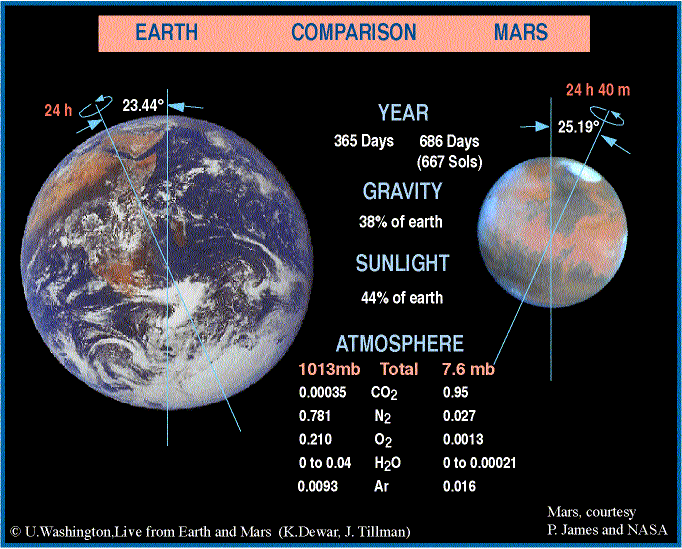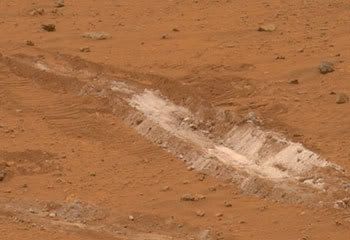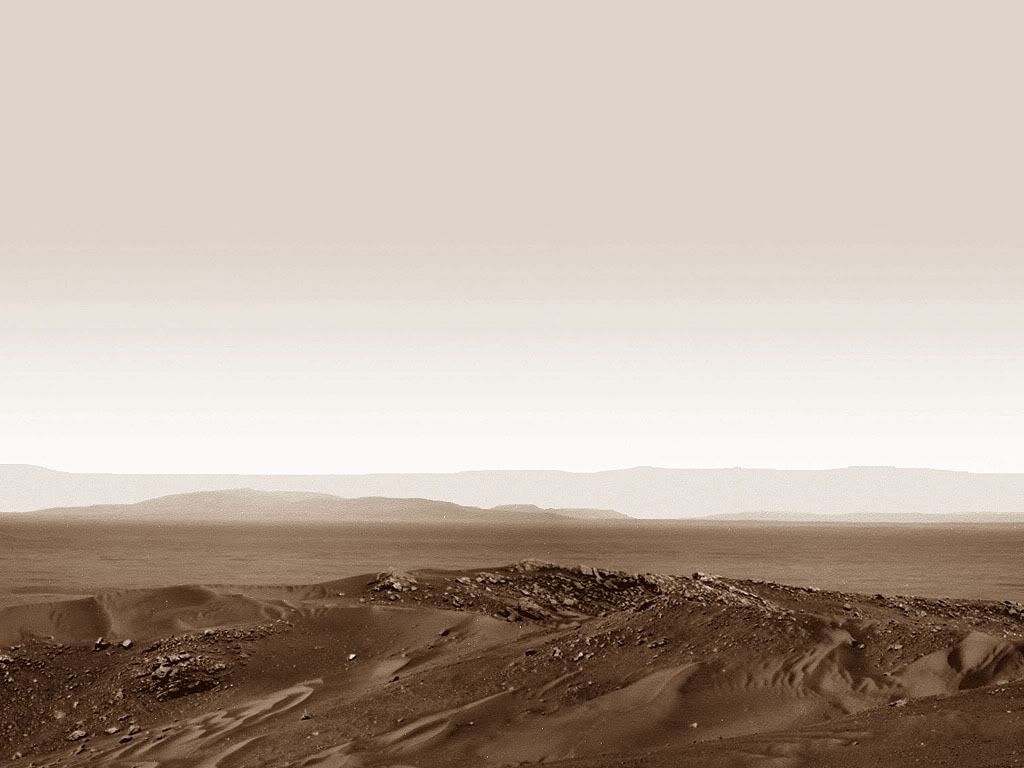http://en.wikipedia.org/wiki/Mars
http://www.answers.com/topic/mars


Google Mars
http://www.google.com/mars/
The Mars Society
http://www.marssociety.org/portal

Mars rover finds evidence of water
http://www.timesonline.co.uk/tol/news/uk/science/article1824283.ece
A broken wheel on one of the Nasa rovers that has been roaming Mars for three and a half years has helped scientists to find strong new evidence that the Red Planet was once wetter and possibly capable of supporting life.
Analysis of a patch of soil that was churned up by the stuck wheel on the the Spirit rover has revealed it is composed of about 90 per cent pure silica — a mineral that would have required the presence of water to form.
The find has surprised and delighted researchers, who said it is among the most significant discoveries made by Spirit since it landed on Mars in January 2003.
It adds to growing evidence, amassed by the Nasa rovers and orbiting spacecraft such as Europe’s Mars Express in recent years, that suggest Mars was once much warmer and wetter than it is today, and that it may have harboured life.
Steve Squyres of Cornell University in New York state, who leads the rover team, said: “You could hear people gasp in astonishment.
“This is a remarkable discovery. And the fact that we found something this new and different after nearly 1,200 days on Mars makes it even more remarkable. It makes you wonder what else is still out there.”
The Spirit rover and its twin, Opportunity, were originally intended to operate for just three months, and though they are still going more than three years after that period they are showing signs of age.
One of Spirit’s six wheels no longer rotates, and thus cuts a deep track as it is dragged through the Martian ground, and this has provided scientists with a serendipitous opportunity to examine the deep-lying soil it has disturbed.
The latest patch was examined using Spirit’s thermal emission spectrometer, which found a high silica content. Minerals of such purity require water to form, and one possible explanation is that it was laid down when volcanic acidic vapours interacted with water at the surface. Another is as a result of hot spring activity.
Steve Ruff of Arizona State University, who leads the thermal emission spectrometer team, said: “We’ve looked at dozens of disturbed soil targets in the rover tracks, and this is the first one that shows a high silica signature.”
The disturbed patch, which lies in the Gusev Crater region of Mars, has been named Gertrude Weise, after a player in the All-American Girls Professional Baseball League.
Doug McCuistion, director of Nasa’s Mars Exploration Programme, said, “This unexpected new discovery is a reminder that Spirit and Opportunity are still doing cutting-edge exploration more than three years into their extended missions. It also reinforces the fact that significant amounts of water were present in Mars’s past, which continues to spur the hope that we can show that Mars was once habitable and possibly supported life.”
David Des Marais, an astrobiologist at Nasa’s Ames Research Centre, in Moffett Field, California, said: “What’s so exciting is that this could tell us about environments that have similarities to places on Earth that are clement for organisms.”
Spirit worked within about 50 yards of the Gertrude Weise area for more than 18 months before the discovery was made.
Dr Squyres said: “This discovery has driven home to me the value of in-depth, careful exploration. This is a target-rich environment, and it is a good thing we didn’t go hurrying through it.”

New dirt on Mars stops scientists in tracks
http://www.news.com.au/story/0,23599,21777106-5011761,00.html
SOME of the strongest evidence yet that ancient Mars was much wetter than it is now was discovered because of a broken wheel on the Mars rover Spirit, NASA scientists say.
Members of Spirit's team discovered a patch of soil that was made up of about 90 per cent pure silica - a composition that would have required the presence of water - after one of the rover's six wheels stopped rotating and left a deep track as it dragged through the soil.
NASA scientists said it was a remarkable discovery that "continues to spur the hope that we can show that Mars was once habitable and possibly supported life".
Spirit has already found other indicators of previous water at the site - patches of water-bearing, sulfur-rich soil; alteration of minerals; and evidence of explosive volcanism - while exploring hills inside a basin named Gusev Crater.
Albert Yen, a geochemist at NASA's Jet Propulsion Laboratory in Pasadena, said: "This is some of the best evidence Spirit has found for water at Gusev."
One possible origin for the silica could have been interaction of soil with acid vapours produced by volcanic activity in the presence of water, a NASA spokesman said. Another could have been from water in a hot spring environment.
David Des Marais, an astrobiologist at NASA's Ames Research Centre in Moffett Field, California, said: "What's so exciting is that this could tell us about environments that have similarities to places on Earth that are clement for organisms."
The Spirit and its twin rover, Opportunity, completed their three-month prime missions in April 2004, but continue to work despite signs of age.
The churning of the soil caused by the Spirit's broken wheel had exposed several patches of bright soil, leading to some of its biggest discoveries at Gusev, including this latest one, a NASA spokesman said.
Doug McCuistion, director of NASA's Mars Exploration Program, said: "This unexpected new discovery is a reminder that Spirit and Opportunity are still doing cutting-edge exploration more than three years into their extended missions. It also reinforces the fact that significant amounts of water were present in Mars's past, which continues to spur the hope that we can show that Mars was once habitable and possibly supported life."
Steve Squyres, principal investigator for the Mars rovers' science instruments, said: "You could hear people gasp in astonishment." Mr Squyres, of Cornell University, Ithaca, New York, said: "This is a remarkable discovery. And the fact that we found something this new and different after nearly 1200 days on Mars makes it even more remarkable. It makes you wonder what else is still out there."
Breathtaking views of Deuteronilus Mensae on Mars
http://www.huliq.com/22357/breathtaking-views-of-deuteronilus-mensae-on-mars
Dust storms causing global warming on Mars?
Temperature increase could be shrinking the planet's polar ice caps.
http://www.msnbc.msn.com/id/17952631/Mars Melt Hints at Solar, Not Human, Cause for Warming, Scientist Says
http://news.nationalgeographic.com/news/2007/02/070228-mars-warming.html
Simultaneous warming on Earth and Mars suggests that our planet's recent climate changes have a natural—and not a human-induced—cause, according to one scientist's controversial theory.
Earth is currently experiencing rapid warming, which the vast majority of climate scientists says is due to humans pumping huge amounts of greenhouse gases into the atmosphere. (Get an overview: "Global Warming Fast Facts".)
Mars, too, appears to be enjoying more mild and balmy temperatures.
In 2005 data from NASA's Mars Global Surveyor and Odyssey missions revealed that the carbon dioxide "ice caps" near Mars's south pole had been diminishing for three summers in a row.
Habibullo Abdussamatov, head of space research at St. Petersburg's Pulkovo Astronomical Observatory in Russia, says the Mars data is evidence that the current global warming on Earth is being caused by changes in the sun.
"The long-term increase in solar irradiance is heating both Earth and Mars," he said.
Solar Cycles
Abdussamatov believes that changes in the sun's heat output can account for almost all the climate changes we see on both planets.
Mars and Earth, for instance, have experienced periodic ice ages throughout their histories.
"Man-made greenhouse warming has made a small contribution to the warming seen on Earth in recent years, but it cannot compete with the increase in solar irradiance," Abdussamatov said.
By studying fluctuations in the warmth of the sun, Abdussamatov believes he can see a pattern that fits with the ups and downs in climate we see on Earth and Mars.
Abdussamatov's work, however, has not been well received by other climate scientists.
His views are completely at odds with the mainstream scientific opinion," said Colin Wilson, a planetary physicist at England's Oxford University.
"And they contradict the extensive evidence presented in the most recent IPCC [Intergovernmental Panel on Climate Change] report." (Related: "Global Warming 'Very Likely' Caused by Humans, World Climate Experts Say" [February 2, 2007].)
Amato Evan, a climate scientist at the University of Wisconsin, Madison, added that "the idea just isn't supported by the theory or by the observations."
Planets' Wobbles
The conventional theory is that climate changes on Mars can be explained primarily by small alterations in the planet's orbit and tilt, not by changes in the sun.
"Wobbles in the orbit of Mars are the main cause of its climate change in the current era," Oxford's Wilson explained. (Related: "Don't Blame Sun for Global Warming, Study Says" [September 13, 2006].)
All planets experience a few wobbles as they make their journey around the sun. Earth's wobbles are known as Milankovitch cycles and occur on time scales of between 20,000 and 100,000 years.
These fluctuations change the tilt of Earth's axis and its distance from the sun and are thought to be responsible for the waxing and waning of ice ages on Earth.
Mars and Earth wobble in different ways, and most scientists think it is pure coincidence that both planets are between ice ages right now.
"Mars has no [large] moon, which makes its wobbles much larger, and hence the swings in climate are greater too," Wilson said.
No Greenhouse
Perhaps the biggest stumbling block in Abdussamatov's theory is his dismissal of the greenhouse effect, in which atmospheric gases such as carbon dioxide help keep heat trapped near the planet's surface.
He claims that carbon dioxide has only a small influence on Earth's climate and virtually no influence on Mars.
But "without the greenhouse effect there would be very little, if any, life on Earth, since our planet would pretty much be a big ball of ice," said Evan, of the University of Wisconsin.
Most scientists now fear that the massive amount of carbon dioxide humans are pumping into the air will lead to a catastrophic rise in Earth's temperatures, dramatically raising sea levels as glaciers melt and leading to extreme weather worldwide.
Abdussamatov remains contrarian, however, suggesting that the sun holds something quite different in store.
"The solar irradiance began to drop in the 1990s, and a minimum will be reached by approximately 2040," Abdussamatov said. "It will cause a steep cooling of the climate on Earth in 15 to 20 years."

Mars Emerging from Ice Age, Data Suggest
http://www.space.com/scienceastronomy/mars_ice-age_031208.html
Scientists have suspected in recent years that Mars might be undergoing some sort of global warming. New data points to the possibility it is emerging from an ice age.
NASA's Mars Odyssey orbiter has been surveying the planet for nearly a full Martian year now, and it has spotted seasonal changes like the advance and retreat of polar ice. It's also gathering data of a possible longer trend.
There appears to be too much frozen water at low-latitude regions -- away from the frigid poles -- given the current climate of Mars. The situation is not in equilibrium, said William Feldman of the Los Alamos National Laboratory.
"One explanation could be that Mars is just coming out of an ice age," Feldman said. "In some low-latitude areas, the ice has already dissipated. In others, that process is slower and hasn't reached an equilibrium yet. Those areas are like the patches of snow you sometimes see persisting in protected spots long after the last snowfall of the winter."
Frozen water makes up as much as 10 percent of the top 3 feet (1 meter) of surface material in some regions close to the equator. Dust deposits may be covering and insulating the lingering ice, Feldman said.
Feldman is the lead scientist for an Odyssey instrument that assesses water content indirectly through measurements of neutron emissions. He and other Odyssey scientists described their recent findings today at the fall meeting of the American Geophysical Union in San Francisco.
"Odyssey is giving us indications of recent global climate change in Mars," said Jeffrey Plaut, project scientist for the mission at NASA's Jet Propulsion Laboratory.
High latitude regions of Mars have layers with differing ice content within the top 20 inches (half-meter) or so of the surface, researchers conclude from mapping of hydrogen abundance based on gamma-ray emissions.
"A model that fits the data has three layers near the surface," said William Boynton of the University of Arizona, Tucson, team leader for the gamma-ray spectrometer instrument on Odyssey. "The very top layer would be dry, with no ice. The next layer would contain ice in the pore spaces between grains of soil. Beneath that would be a very ice-rich layer, 60 to nearly 100 percent water ice."
Boynton interprets the iciest layer as a deposit of snow or frost, mixed with a little windblown dust, from an era when the climate was colder than nowadays. The middle layer could be the result of changes brought in a warmer era, when ice down to a certain depth dissipated into the atmosphere. The dust left behind collapsed into a soil layer with limited pore space for returning ice.
More study is needed to determine for sure what's going on.
Other Odyssey instruments are providing other pieces of the puzzle. Images from the orbiter's camera system have been combined into the highest resolution complete map ever made of Mars' south polar region.
"We can now accurately count craters in the layered materials of the polar regions to get an idea how old they are," said Phil Christensen of Arizona State University, Tempe, principal investigator for the camera system.
Temperature information from the camera system's infrared imaging has produced a surprise about dark patches that dot bright expanses of seasonal carbon-dioxide ice.
"Those dark features look like places where the ice has gone away, but thermal infrared maps show that even the dark areas have temperatures so low they must be carbon-dioxide ice." Christensen said. "One possibility is that the ice is clear in these areas and we're seeing down through the ice to features underneath."


Mars face myth is now over the hill
http://www.theage.com.au/news/world/mars-face-myth-is-now-over-the-hill/2006/09/23/1158431949593.html
One of the more famous myths of the space age, the so-called "Face on Mars", has finally been debunked after new photos clearly showed that it is just a heavily eroded hill.
The European Space Agency's Mars Express probe, which has been orbiting the Red Planet since 2003, managed to get a clear look at the hill after being frustrated by dust and haze on earlier passes.
Sadly, the photos show that the kilometre-wide Face and other supposedly artificial structures in Mars' Cydonia region are just quirks of geology.
"These images of the Cydonia region on Mars are truly spectacular," said Agustin Chicarro, a Mars Express project scientist. "They not only provide a completely fresh and detailed view of an area famous to fans of space myths worldwide, but also provide an impressive close-up over an area of great interest for planetary geologists."
The Face on Mars myth is based on a photo of Cydonia taken by NASA's Viking probes in 1976. A NASA press release said the rock formation was "formed by shadows giving the illusion of eyes, nose and mouth".
Despite the disclaimer, the photo seems to have fired some people's imagination. Far clearer photos of the region taken in 1998 and 2001 by NASA's Mars Global Surveyor craft killed the Face explanation for many.
The "Face on Mars"
http://www.msss.com/education/facepage/face.html
"The Face on Mars" in Cydonia
Cydonia, is there more then meets the eye?
Mars: The Face & Pyramids of Mars












![Brotherhood" (2006) [TV-Series]](http://photos1.blogger.com/x/blogger2/1421/379621144723082/211/z/425926/gse_multipart33129.jpg)







1 comment:
New studies suggest that Mars goes through phases of glacial formation and melting in a cycle that spans 51,000 Earth-years. This coincides with regular inversions of the Martian poles. More of the topic may be found here: http://www.thenewsroom.com/details/495959/Science+and+Technology?c_id=wom-bc-ar
- Alvin from The Sci-Tech Desk at TheNewsRoom.com
Post a Comment